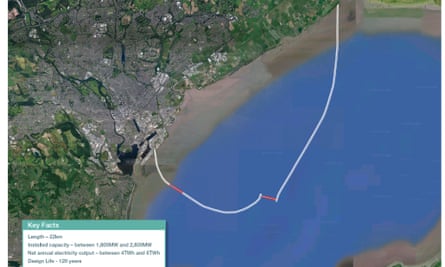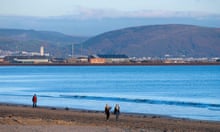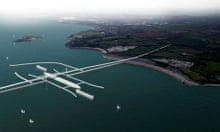The company planning to build a series of massive tidal lagoons in the UK claim their project can generate electricity that will be competitive with offshore wind and nuclear power. But experts have urged the government to take a cautious approach to the massive capital investment.
The world’s first tidal lagoon power station is ready to begin construction in Swansea, Wales should it attain planning approval. The project has been criticised for its exorbitant electricity costs, estimated to be £168/MWh. When the project begins generation in 2018, onshore wind will be producing electricity for less than half of this price.
But Tidal Lagoon Power (TLP), the company behind the projects, says the Swansea development is simply a proof of concept and tidal power at scale will produce affordable power. On Monday the company announced the beginning of the approval process for a second site near Cardiff where construction could begin by 2018 and power generation by 2022.
The second lagoon will cover an area seven times larger than Swansea’s and will have a capacity of between 1,800-2,800MW, enough to power 1.5m homes (compared with 150,000 for the first lagoon). Most importantly, the company says, the larger scale will allow them to produce power at £90-95/MWh, which will make the project cheaper than offshore wind and competitive with nuclear.
Mark Shorrock, TLP’s chief executive says the fall in cost will occur because of the expertise accrued through the construction of the Swansea plant combined with the economies of scale of building the much larger lagoon.
“Full-scale tidal lagoon infrastructure gives the UK an opportunity to generate electricity from our amazing tidal range at a cost comparable to fossil fuel or nuclear generation. We have the best tidal resource in Europe and the second best worldwide. We now have a sustainable way to make the most of this natural advantage,” says Shorrock.

The secretary of state for energy and climate change Ed Davey has repeatedly expressed his enthusiasm for the technology.
“I’ve looked at a whole range of different forms of renewable electricity options for the future for large scale deployment. And obviously we are doing an awful lot on offshore wind, which has huge promise at very very big scale. But when you look at the alternatives the one technology that looks like it could be a runner to give us a big amount of renewable electricity looks to me like tidal lagoons,” he says.
Will Straw, a research director at the Institute for Public Policy Research, says the investment is imperative to meeting the UK’s emissions reduction target of 80% by 2050.
“I don’t think we have a choice but to invest in some new renewable technologies as well as existing proven renewable technologies. I simply don’t think that we have the physical space and public acceptability for the amount of existing renewable that we would need to meet our longer term 2050 objectives.”
But there are key hurdles before either of the projects are realised. Davey’s department is consulting on how best to negotiate government support for tidal lagoon power. One proposal to engage in a bilateral haggle with the company has been criticised by the Citizens Advice Bureau (CAB) for choking competition and transparency.

The money to subsidise the projects will come from a pot of money levied on energy bills. TLP say their projects will need about 1% of the money given to renewable projects each year.
Colin Brown, the director of engineering at the Institution of Mechanical Engineers, says the technology itself does not pose a major challenge but that the size of even the pilot means the costs of unforeseen delays or malfunctions will be very high.
“It’s absolutely deliverable. It’s the cost that its deliverable at [that is the issue]. In the crudest terms it’s a few turbines that we would use in a hydroelectric plant ... It’s walls of rock and stone. I don’t think we’d need to split the atom here, this is relatively straightforward stuff. The issue is it’s on such a huge scale and such a high capital scale that if they do find that they’ve got a maintenance charge that’s out by 5% it’ll hugely change the cost of the electricity that comes out of it,” he says.
The potential for things to go wrong at huge scale and the novelty of the technology means the government should proceed with caution, says Professor Jim Watson, research director at the UK Energy Research Centre.
TLP says the Cardiff project could begin construction by 2018 and be generating power by 2022, meaning there would be some overlap with the first lagoon pilot period. It would be imprudent, says Watson, to commit consumers’ money to the second project before the pilot is proven to come in at cost and in time.
“It would be taking a very big risk to do both at once because the second one is very large indeed and therefore the scope for it going wrong is much bigger. So I think a step-by-step approach would work given that this is new,” said Watson.
But Watson says the exciting prospect of a technology that its advocates believe could produce up to 8% of the UK’s electricity is worth investing in.
“If the 8% of UK electricity figure is quoted is true that’s very, very significant indeed ... Because of that potential being quite significant then it does pay to use some public money to support the early stages of the technology and see whether it can deliver.”
In spite of his obvious excitement about the technology, Davey agrees: “Until you deploy one, you can’t be sure this is the right way to go.”





Comments (…)
Sign in or create your Guardian account to join the discussion